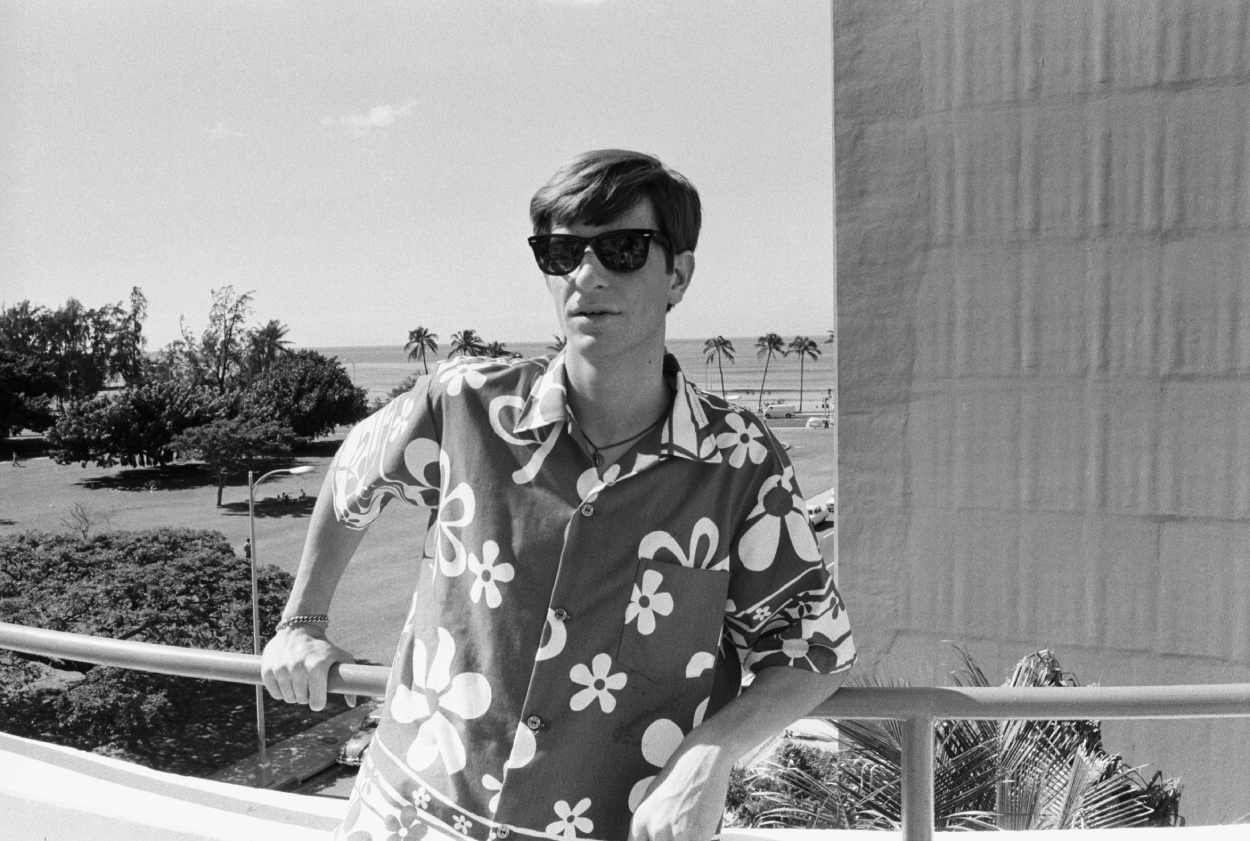NBA
Pete Maravich: Biography, Career, Top Stories for the NBA and College Basketball Hall of Famer

If he isn’t the best college basketball player ever, Pete Maravich was certainly the most exciting.
The man known as “Pistol Pete” could score with the best of them. In fact, he is the best of them. For 53 years, Maravich has been the all-time NCAA Division I scoring leader with 3,667 career points. If that’s not impressive, how he accomplished those numbers certainly is.
Maravich attended LSU, where he played for his father, Press. He played just three seasons because freshmen weren’t allowed to play at the varsity level back then. He also played without the benefit of a three-point line or a shot clock. While players brag about having 1,000-point careers, Maravich had three 1,000-point campaigns with the Tigers.
In his first season, Maravich racked up 1,138 points by averaging 43.8 points per game. From there, his stats only improved. He averaged 44.2 points as a junior and 44.5 as a senior. He collected 3,667 points in 83 games.
The Atlanta Hawks made Maravich the third overall pick in the 1970 NBA Draft. He played 10 seasons in the NBA, most notably with the New Orleans/Utah Jazz, and was a five-time All-Star.
Article contents

- Quick facts
- Early life and high school
- College career
- NBA career
- College stats
- NBA stats
- Best college basketball player ever?
- Nicknames
- Awards and achievements
- The death of Pete Maravich
- FAQ
Quick Pete Maravich facts
- Birthday: June 22, 1947
- Died: Jan. 5, 1988
- Birthplace: Aliquippa, Pennsylvania
- Parents: Petar “Press” Maravich, Helen Gravor Maravich
- Children: Jaeson Maravich, Josh Maravich
- Siblings: Ronnie Maravich, Diana Marie Maravich
- Listed height: 6-foot-5
- Listed weight: 197 pounds
- High school: Daniel (Central, South Carolina), Broughton (Raleigh, North Carolina)
- College: LSU (1967-70)
- NBA draft: Round 1, Pick No. 3 by the Atlanta Hawks in the 1970 NBA Draft
- NBA team: Atlanta Hawks, New Orleans/Utah Jazz, Boston Celtics
- NBA position: Guard
- NBA number: Nos. 7, 44
- NBA playing career: 1970-80
- Marital status: Jackie (Elliser) Maravich, wife
Where did Pete Maravich grow up?

Being the son of a basketball coach, Maravich got started in the sport at an early age. He was born in Aliquippa, Pennsylvania, but moved around as his father changed coaching jobs.
Maravich initially attended Daniel High School in Central, South Carolina, as Press coached at Clemson University. When Press landed a coaching job at North Carolina State, Pete was forced to transfer and attended Needham B. Broughton High School.
After graduating from high school, Maravich enrolled at Edwards Military Institute, where he played basketball.
Where did Pete Maravich go to college?
Just as Maravich was about to enroll in college, his father was named the head coach at Louisiana State University. Press and Pete became a package deal as the younger Maravich followed his dad to LSU.
Freshmen weren’t allowed to play at the varsity level back then, so Press was on his own for that 1966-67 season. The Tigers won three games, finishing 3-23.
Pete helped turn the program around as a sophomore in his first varsity season. In 26 games, he shot 42.3% from the floor and averaged 43.8 points as the Tigers had their first winning year since the 1961-62 season. They finished 14-12.
As a junior, Maravich and the Tigers went 13-13, but he continued his torrid scoring. Pistol Pete improved his shooting percentage to 44.4% and averaged 44.2 points. As a senior, he upped his average to 44.5 and helped guide the Tigers to a fourth-place finish in the NIT.
Everyone wanted to see Maravich play. He drew crowds everywhere he went. He wowed fans with his scoring, but he also was a showman with his fancy passing. Maravich always said he’d rather pass the ball than shoot.
“There’s one misconception I’d like to clear up,” Maravich wrote in a first-person Sports Illustrated article ahead of his senior year in 1969. “When most people hear the name Maravich, all they think of is a skinny kid who shoots all the time.
“Well, I do shoot a lot. But, and this may sound funny, shooting is not really my game. Passing is. Passing and ball handling and dribbling. That is the most exciting part of my game, the most devastating part, the part that people come out to see, the part I like to talk about.”
To this day, Maravich still owns the record for most points in Division I history with 3,667. That record was in jeopardy when Antoine Davis, a fifth-year player out of Detroit Mercy, finished his career with 3,664 points in 2023.
Maravich was the third overall pick in the 1970 NBA Draft
Not only was Maravich a prolific scorer, but he also was a tremendous passer. The man known for his floppy socks wowed fans with his behind-the-back passes and his no-look assists in college and the NBA. The Hawks selected him third overall in 1970.
Maravich played four seasons with the Hawks, earning two All-Star nods. He averaged 24.3 points in those four years. When the New Orleans Jazz came into the NBA as an expansion team for the 1974-75 season, they needed some drawing power.
What better player to go after than Maravich, who was beloved in Louisiana after his record-setting college days? The Jazz sent two players and five draft picks to the Hawks to acquire the hot-shot guard.
Outside of Maravich, the Jazz didn’t have much talent. They didn’t have much of a future either after surrendering many picks to land the star. Maravich often was criticized for losing seasons in New Orleans.
“That trade,” said Maravich in February 1975, per Sports Illustrated. “I didn’t make the trade. Why do people ask me about it? People have to criticize something and when I’m around, it’s usually me.”
Maravich played six seasons with the New Orleans/Utah Jazz, earning three straight All-Star nods in his final three seasons in New Orleans.
When the team moved to Utah for the 1979-80 season, Maravich was injured and released after playing 17 games. The Boston Celtics signed him for the stretch run, teaming him with a rookie named Larry Bird. Maravich appeared in 26 regular-season games with the Celtics.
He was inducted into the Naismith Memorial Basketball Hall of Fame in 1987.
Pete Maravich’s college stats
| Season | Games | PTS | REB | AST | FG% |
|---|---|---|---|---|---|
| 1967-68 | 26 | 43.8 | 7.5 | 4.0 | 42.3 |
| 1968-69 | 26 | 44.2 | 6.5 | 4.9 | 44.4 |
| 1969-70 | 31 | 44.5 | 5.3 | 6.2 | 44.7 |
Pistol Pete’s NBA stats
| Season | Games | PTS | REB | AST | FG% | MPG |
|---|---|---|---|---|---|---|
| 1970-71 | 81 | 23.2 | 3.7 | 4.4 | 45.8 | 36.1 |
| 1971-72 | 66 | 19.3 | 3.9 | 6.0 | 42.7 | 34.9 |
| 1972-73 | 79 | 26.1 | 4.4 | 6.9 | 44.1 | 39.1 |
| 1973-74 | 76 | 27.7 | 4.9 | 5.2 | 45.7 | 38.2 |
| 1974-75 | 79 | 21.5 | 5.3 | 6.2 | 41.9 | 36.1 |
| 1975-76 | 62 | 25.9 | 4.8 | 5.4 | 45.9 | 38.3 |
| 1976-77 | 73 | 31.1 | 5.1 | 5.4 | 43.3 | 41.7 |
| 1977-78 | 50 | 27.0 | 3.6 | 6.7 | 44.4 | 40.8 |
| 1978-79 | 49 | 37.2 | 2.5 | 5.0 | 42.1 | 37.2 |
| 1979-80 | 43 | 13.7 | 1.8 | 1.9 | 44.9 | 22.4 |
Is Maravich the best college basketball player ever?
If Maravich isn’t the best college basketball player ever, he’s certainly in the top three. He, Lew Alcindor (Kareem Abdul-Jabbar), and Bill Walton are all deserving of the college GOAT honor.
If the voting is based strictly on numbers, Maravich wins easily. If it’s based on championships, he’s certainly not No. 1.
Maravich collected 3,667 career points while at LSU, averaging 44.2 points per game in his three seasons. He came to LSU as a hyped-up freshman, but NCAA rules prohibited freshmen from playing with the varsity. Former teammate Ralph Jukkola told Sportscasting the hype intrigued him, so he and a few upperclassmen went to watch the freshmen to see what the fuss was all about.
“We didn’t know who he was,” Jukkola said. “The freshmen were playing pickup. We were like let’s go see what this hot-shot kid is all about. We saw them standing there and couldn’t figure out which one he was. There was this kid about 155-160 pounds, skinny kid. Is that him?
“Then when you play against him or play with him, you find out what he can do. He was legit. His talent was above and beyond what we had.”
Nobody has scored more points in Division I college basketball than Maravich. The record was threatened in 2023 when fifth-year guard Antoine Davis of Detroit Mercy came up three points shy of tying the mark.
Although Maravich never played in the NCAA tourney, he sparked a turnaround for a struggling LSU program that won three games before he got to the varsity level. As a sophomore, he helped the Tigers improve to 14-12 before going 13-13 as a junior. As a senior, Maravich led LSU to the NIT, where they earned a fourth-place finish.
Why was Maravich called Pistol Pete?
When you hear the name “Pistol Pete,” you know they’re talking about Maravich, the player with the flailing hair and the floppy socks. Maravich was always a skinny kid but was never shy about launching up the basketball.
Maravich had his moniker throughout college and in the NBA. In fact, the nickname “Pistol Pete” was born even before he made his way into high school.
Maravich once explained how he got his famous nickname.
“For one thing, I used to always take hook shots from 15 and 20 feet away in junior high,” he wrote in a first-person Sports Illustrated article in 1969. “It was easier for me to get the ball up there that way.
“I also shot from the hip because I wasn’t strong enough to get the ball high on my chest or over my shoulder. I was about 4-11 then, maybe 85 pounds, really a spaghetti. And I fired it one-handed from the hip. I think that’s when somebody first called me Pistol.”
The nickname stuck through college and carried over into the NBA.
Pete Maravich’s awards and achievements
Maravich was an offensive machine in both college and the NBA. He’s clearly the best scorer in NCAA history, and he also became an NBA Hall of Famer. While he never brought home a championship, he certainly collected his share of awards and achievements.
- NBA Hall of Fame (1987 inductee)
- College Hall of Fame (1987 inductee)
- 50th Anniversary All-Time Team inclusion
- 75th Anniversary Team inclusion
- No. 23 jersey retired by LSU, No. 44 jersey retired by the Atlanta Hawks, No. 7 jersey retired by the Utah Jazz, and No. 7 jersey retired by the New Orleans Pelicans
- Two-time National College Player of the Year (1969, 1970)
- Three-time consensus first-team All-American (1968-70)
- Three-time SEC Player of the Year (1968-70)
- Three-time NCAA scoring champion (1968-70)
- NCAA all-time Division I scoring leader
- NBA scoring champion (1977)
- NBA five-time All-Star (1973, 1974, 1977-79)
- Two-time All-NBA First Team (1976, 1977)
- Two-time All-NBA Second Team (1973, 1978)
The death of Pete Maravich
Maravich, who played his final NBA game with the Boston Celtics in the 1980 postseason, died On Jan. 5, 1988. He collapsed while playing a game of pickup basketball in Pasadena, California. He was 40.
According to Mark Kriegel’s book PISTOL: The Life of Pete Maravich, the autopsy found that Maravich was born without a left artery complex and died of deterioration of the tissues in his heart because of the congenital abnormality. According to the book, that type of defect typically kills its victims before they turn 20.
Maravich’s widow, Jackie, believed her late husband’s downfall began nine months earlier when Press died. Just before his father died on April 15, 1987, Maravich told him, “I’ll see you soon,” per Kriegel.
Those four words stuck with Jackie. During that short stretch between Press’ death and Maravich’s, she saw signs. She noticed his weight loss and the physical pain emanating from his shoulder. She believed it all happened with Press’ passing.
“Once that happened,” Jackie said, per Kriegel, “it was all downhill. Did Pete know something? I think so. I really think he did. He didn’t want to upset me.
“I believe that, when people say that someone died of a broken heart.”
Pete Maravich FAQ
Pete Maravich was born in Aliquippa, Pennsylvania, on June 22, 1947.
Pete Maravich died on Jan. 5, 1988. He was 40.
Pete Maravich died of heart failure while playing a game of pickup basketball.
Pete Maravich was 6-foot-5.
Pete Maravich weighed 197 pounds during his playing days.
Pete Maravich played three years of college basketball at LSU. He played for his father, Press, and attended the school from 1967 to 1970.
In his three seasons at LSU, Pete Maravich averaged 44.2 points per game.
Pete Maravich was drafted by the Atlanta Hawks with the third overall pick in the 1970 NBA Draft.
Pete Maravich played for the Atlanta Hawks from 1970 to 1974. He also played for the New Orleans/Utah Jazz from 1965 to 1968, and he played for the Los Angeles Lakers from 1974 to 1980. He ended his career with the Boston Celtics, appearing in 26 games during the 1979-80 season.
Pete Maravich was often referred to as “Pistol Pete.”
Pete Maravich never won a title in college or in the NBA.











